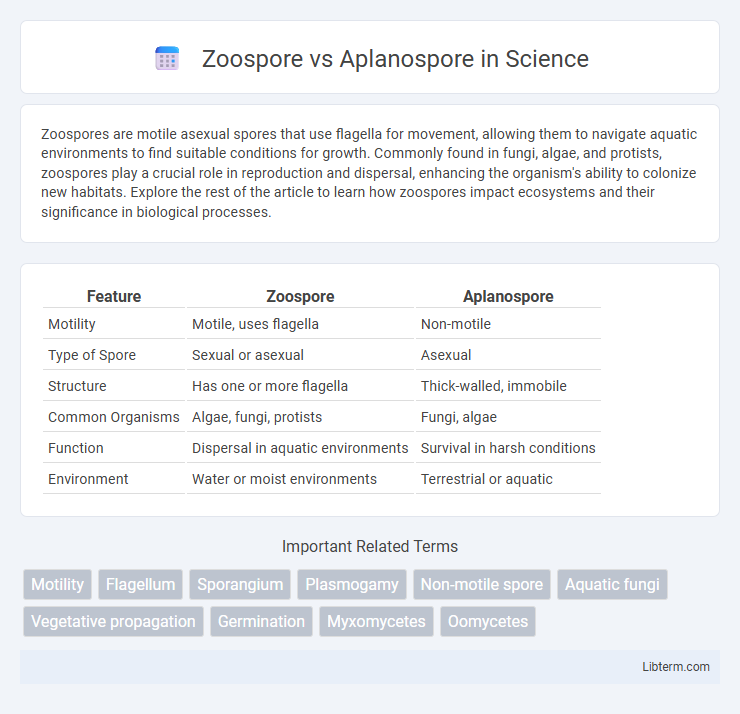Zoospores are motile asexual spores that use flagella for movement, allowing them to navigate aquatic environments to find suitable conditions for growth. Commonly found in fungi, algae, and protists, zoospores play a crucial role in reproduction and dispersal, enhancing the organism's ability to colonize new habitats. Explore the rest of the article to learn how zoospores impact ecosystems and their significance in biological processes.
Table of Comparison
| Feature | Zoospore | Aplanospore |
|---|---|---|
| Motility | Motile, uses flagella | Non-motile |
| Type of Spore | Sexual or asexual | Asexual |
| Structure | Has one or more flagella | Thick-walled, immobile |
| Common Organisms | Algae, fungi, protists | Fungi, algae |
| Function | Dispersal in aquatic environments | Survival in harsh conditions |
| Environment | Water or moist environments | Terrestrial or aquatic |
Introduction to Zoospore and Aplanospore
Zoospores are motile spores equipped with flagella, allowing them to actively swim in aquatic environments to find favorable conditions for growth. Aplanospores, in contrast, are non-motile spores that rely on passive dispersal mechanisms such as water currents or wind for distribution. Both types of spores serve as important reproductive structures in various algae and fungi, facilitating survival and propagation under diverse environmental conditions.
Definition of Zoospore
Zoospores are motile asexual spores equipped with flagella, enabling them to swim in aquatic environments for dispersal and infection. Unlike aplanospores, which are non-motile and rely on passive movement, zoospores actively seek out suitable substrates or hosts. Zoospores play a critical role in the life cycles of many algae, fungi, and protists, facilitating rapid colonization and reproduction in moist conditions.
Definition of Aplanospore
Aplanospores are non-motile spores produced by certain algae and fungi as a means of asexual reproduction, remaining stationary without flagella. Unlike zoospores, which are motile and use flagella for movement in aquatic environments, aplanospores rely on external factors such as water currents or animals for dispersal. Their thick walls provide resistance to unfavorable conditions, aiding in survival until germination occurs.
Key Differences Between Zoospore and Aplanospore
Zoospores are motile spores equipped with flagella, allowing active movement in aquatic environments, whereas aplanospores are non-motile spores that rely on passive dispersal. Zoospores typically facilitate rapid colonization through their ability to swim, while aplanospores tend to endure unfavorable conditions through dormancy. The structural differences include zoospores' flagella for locomotion versus the smooth, immobile surface of aplanospores, impacting their ecological roles and dispersal strategies.
Formation Process of Zoospore
Zoospores are motile spores formed in aquatic fungi and algae through mitotic division within a sporangium, characterized by the development of one or more flagella enabling movement in water. Unlike aplanospores, which are non-motile and rely on passive dispersal, zoospores actively navigate their environment to find suitable substrates for germination. The formation process involves cytoplasmic cleavage and flagellar assembly, crucial for the zoospore's motility and subsequent colonization.
Formation Process of Aplanospore
Aplanospore formation involves the development of a non-motile spore within a thick-walled cyst formed inside the parent cell, ensuring protection during unfavorable conditions. Unlike zoospores, which are motile and equipped with flagella for movement, aplanospores remain stationary and rely on environmental changes to trigger germination. This asexual reproductive process is common in fungi and algae, facilitating survival and propagation without requiring water for dispersal.
Structural Characteristics: Zoospore vs Aplanospore
Zoospores possess flagella, enabling motility in aquatic environments, while aplanospores lack flagella and remain non-motile. Zoospores typically have one or more flagella attached near the anterior end, facilitating active movement, whereas aplanospores rely solely on passive dispersal mechanisms. Structurally, zoospores have a flexible cell membrane to aid in swimming, contrasted with the more rigid, often thick-walled aplanospores designed for durability and resistance to adverse conditions.
Functional Roles in Reproduction
Zoospores function as motile reproductive cells equipped with flagella, enabling them to actively swim toward favorable environments for colonization and growth, which enhances dispersal efficiency in aquatic and moist habitats. Aplanospores, in contrast, are non-motile spores that rely on passive mechanisms such as water currents or physical disturbances for distribution but play a critical role in enduring unfavorable conditions through dormancy. Both zoospores and aplanospores contribute to the life cycle by enabling reproduction and survival, with zoospores facilitating rapid colonization while aplanospores ensure resilience and persistence.
Examples in Algae and Fungi
Zoospores, motile asexual spores equipped with flagella, are commonly found in algae such as Chlamydomonas and fungi like Chytridiomycetes, enabling active movement in aquatic environments. Aplanospores, non-motile asexual spores lacking flagella, occur in algae like Ulva and fungi such as Mucor, relying on passive dispersal through water or air. These differences in spore types illustrate adaptive strategies in reproduction and dispersal across diverse algal and fungal species.
Significance in Biological Life Cycles
Zoospores, equipped with flagella, enable active motility facilitating dispersal in aquatic environments, crucial for colonization and infection processes in protists and fungi. Aplanospores, non-motile and relying on passive mechanisms such as water or wind for distribution, serve as resilient survival structures during unfavorable conditions in algae and fungi. Both spore types play key roles in ensuring species propagation, genetic diversity, and adaptation across diverse ecological niches within biological life cycles.
Zoospore Infographic

 libterm.com
libterm.com